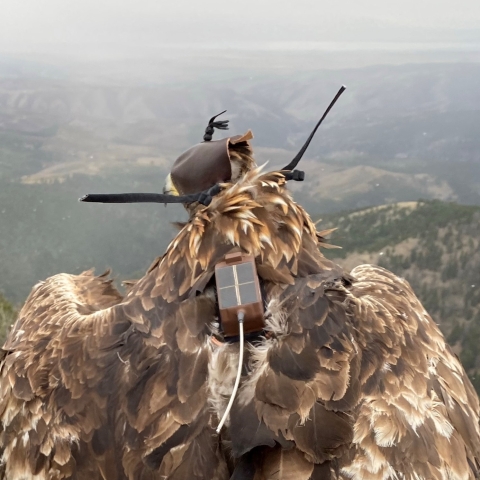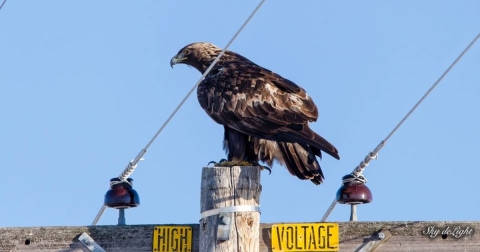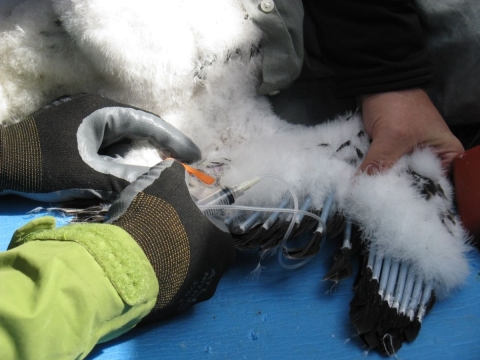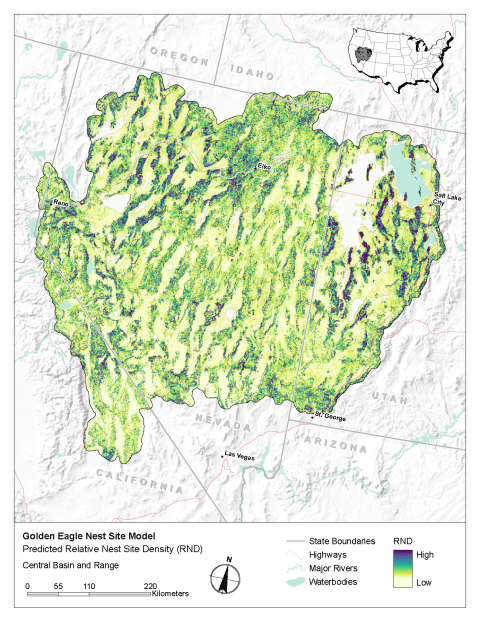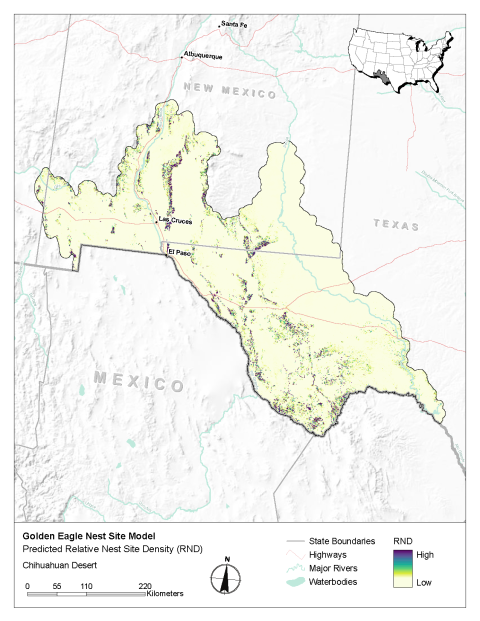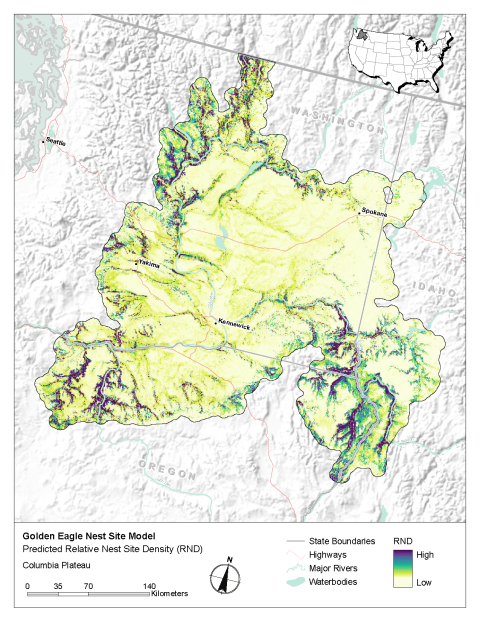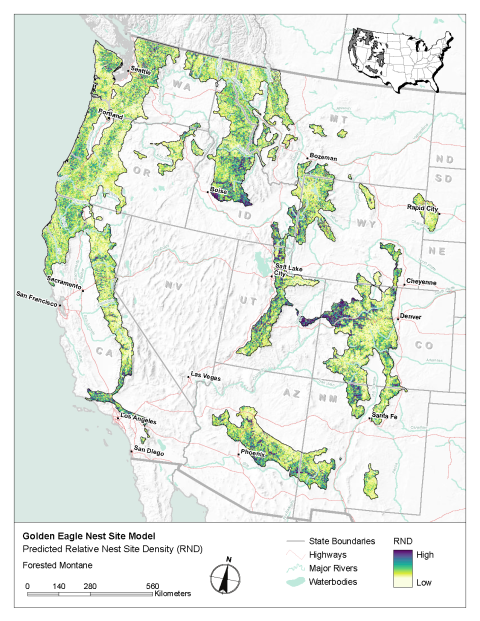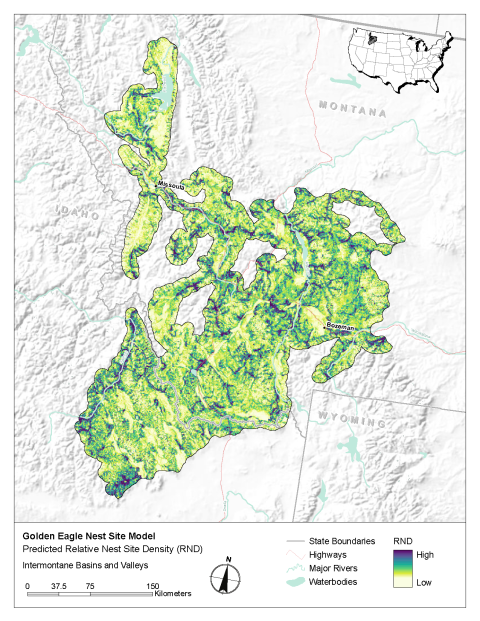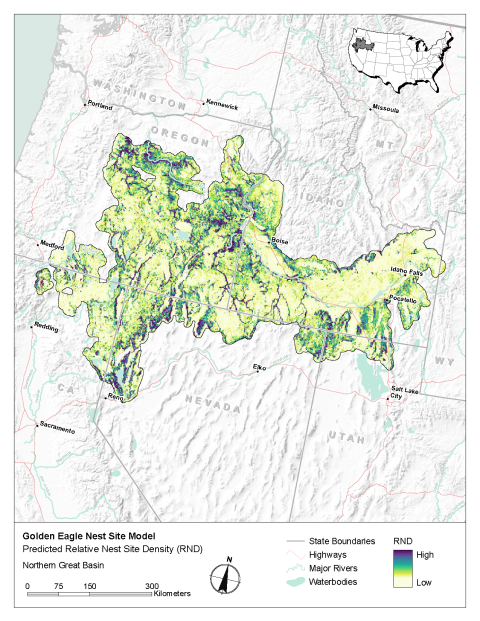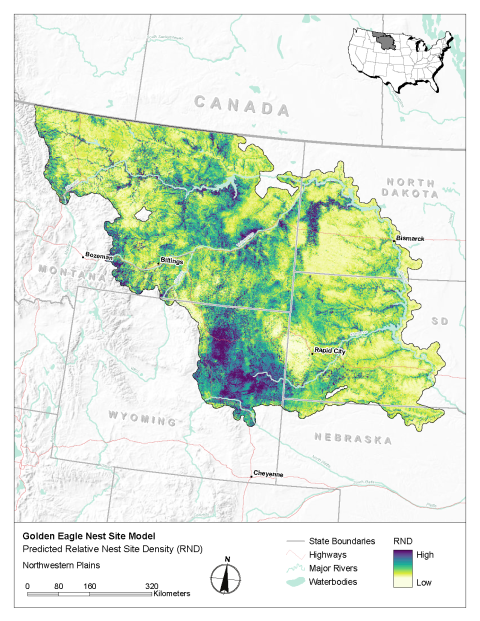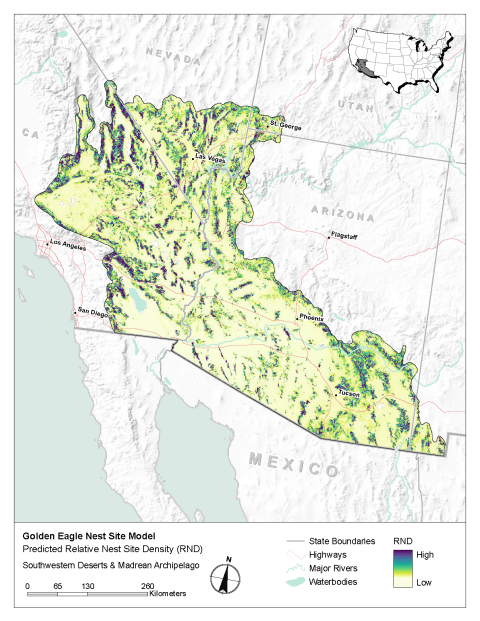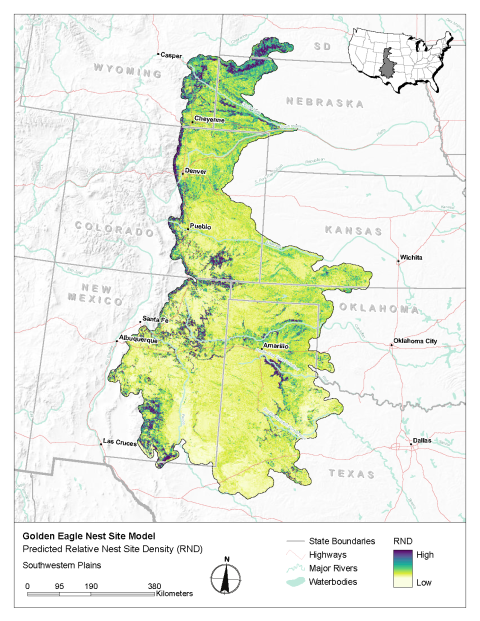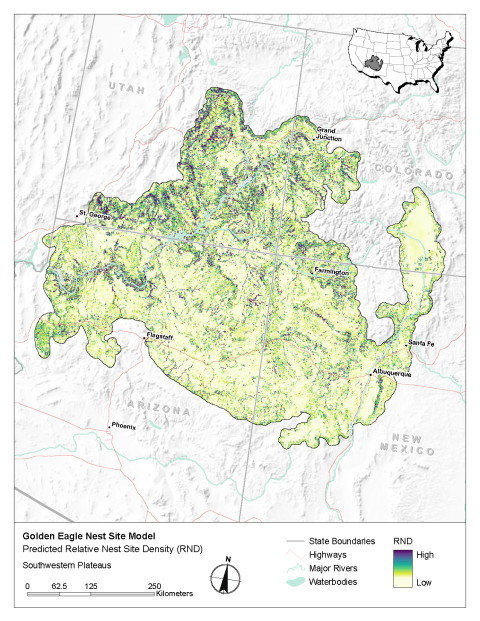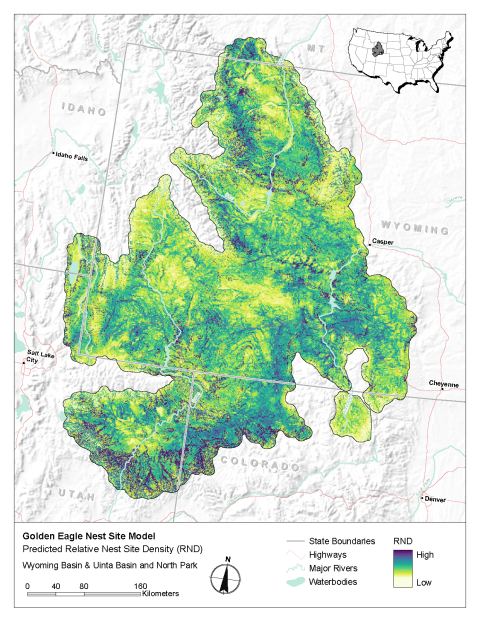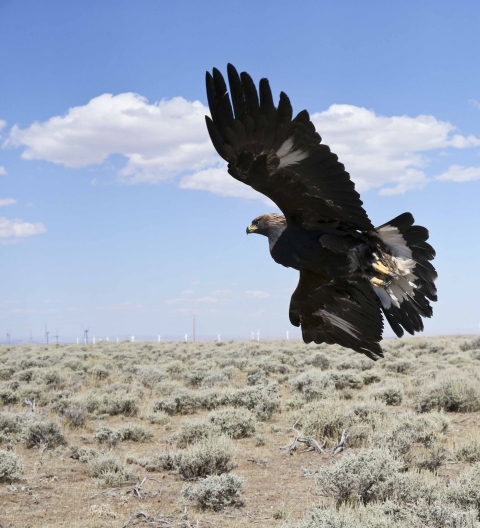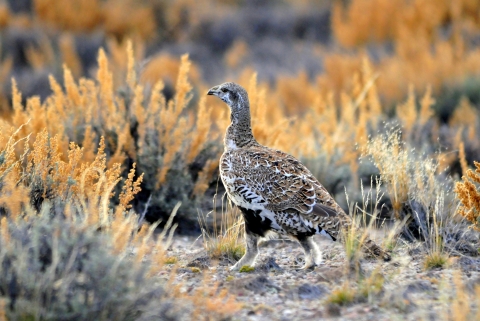Overview
Jump to a section:
Distribution & Movement | Management & Mitigation | Ecoregional Strategies | Risk Analysis Tools
Western Golden Eagle Conservation
Although golden eagles are found throughout the United States, the majority of golden eagles in the U.S. are found west of the Mississippi River. Conservation and management of golden eagles (Aquila chrysaetos) in the western U.S. has gained importance in recent years as rapid expansion of energy development, combined with anthropogenic sources of mortality and habitat alteration, may be causing declines in western golden eagle populations. These concerns, coupled with protection of golden eagles under the Bald and Golden Eagle Protection Act, have generated an urgent need for new information and analysis tools to support eagle conservation programs.
Western Golden Eagle Team
The U.S. Fish and Wildlife Service funded the Western Golden Eagle Team (WGET) from 2013 through 2019 in order to help meet the information needs of golden eagle conservation and management in the western U.S. WGET collaborated with state and federal land management agencies, Tribes, industry partners, and research institutions to develop conservation strategies, decision support tools, and information resources to guide project siting decisions, and support evaluation of project proposals, planning of mitigation efforts, and land management planning.
Conservation Planning Approach
Golden eagles inhabit a diverse array of habitats and exhibit complex seasonal patterns of dispersal and migration encompassing much of western North America. The Service addressed this diversity by employing a systematic conservation planning approach focused on spatially explicit assessments of eagle populations and threats. The assessments are organized by ecoregion, providing managers and stakeholders with planning tools that are tailored to the specific regions where they work. The decision support tools are intended to inform siting of energy development projects (ECPG Stage 1) and land management planning, as well as identification and spatial prioritization of mitigation opportunities (ECPG Stage 4).
Product Organization
WGET products are organized into four sections:
Distribution and Movement: Spatially explicit predictive models of golden eagle distribution and density are the foundation of the Service's decision support tools and risk analyses. This section contains maps and spatial data for breeding and wintering habitats, as well as fall and spring dispersal and migration. These models are intended to be used in desktop analyses to inform development siting and prioritization of conservation and management actions.
Management and Mitigation: Conservation of golden eagles requires understanding the factors that limit their populations, and management and mitigation typically focus on the effects of human activities on eagle populations. This section addresses population limiting factors, such as electrocution, human disturbance, habitat and prey, diseases, and contaminants. These information resources were developed to identify conservation and management priorities and inform compensatory mitigation opportunities, such as retrofitting power poles and establishing conservation banks.
Ecoregional Strategies: The conservation strategies are based on data and modeling results compiled at the scale of ecoregions, and provide regional information, decision support tools and management approaches for direct application in golden eagle conservation. The strategies are intended to be complementary with existing management plans, such as State, Flyway, Tribal, and other regional conservation planning efforts for golden eagles and other species of conservation concern.
Risk Analysis Tools: Golden eagle populations can be negatively impacted by a number of anthropogenic and natural threats. This section provides a spatial prioritization of relative risk to golden eagles within ecoregions and across the western U.S. Risk analyses combine habitat suitability models with models or indices of hazards to rank areas based on the spatial overlap between eagle habitat and a given hazard, such as electrocution, lead exposure, wind energy development, oil and gas development, and wildfire, among others. Understanding the relative magnitude and distribution of risks is an important precursor to the development of conservation strategies aimed at avoiding and minimizing existing and emerging threats to golden eagles.
Helpful Links
Documents
Eagle Conservation Plan Guidance (ECPG)
Avian Powerline Interaction Committee (APLIC) Guidelines
USFWS Western Golden Eagle Team Documents & Publications
------------
______________________________________________________________________________________________________________________________________
Distribution and Movement of Golden Eagles
Jump to a subsection:
Breeding Habitat Models | Winter Distribution & Density | Movement & Migration Models | Space-use by Territorial Adults
Golden eagles inhabit a wide range of habitats across western North America and exhibit complex, large-scale patterns of movement and migration. Conservation planning for golden eagles–whether focused on siting development of renewable energy resources, prioritization of areas for compensatory mitigation actions, or resource management on public lands–is therefore reliant on spatially explicit predictive models of golden eagle distribution and density. Working with a host of collaborators from federal, state and tribal wildlife agencies, research institutions, and private industry, the U.S. Fish and Wildlife Service (Service) developed and tested a series of species distributional models to provide a consistent spatial foundation for golden eagle conservation in the western United States.
The regional-scale distribution and density of golden eagles is influenced by three overlapping life history stages; breeding, dispersal and migration, and overwintering. The size and life history composition of the golden eagle population in a landscape may change seasonally. For example, a given landscape may support only scattered breeding eagles in summer, serve as a corridor for
hundreds of migrating eagles in fall, and then contain many migrant and dispersing eagles during winter; in addition to the resident breeding pairs. Conservation planning for golden eagles must therefore consider life history stages and seasonal variation in eagle distribution and density. Our modeling framework therefore sought to reliably predict the relative density of golden eagles throughout the western conterminous United States during breeding, seasonal dispersal and migration periods, and overwintering.
Our models are intended for application in regional-scale conservation planning and proactive risk assessments (“desk-top analyses”) in support of development siting and prioritization of areas for management action or protection. Model resolution may not be appropriate for applications at finer scales, such as siting individual turbines within a project area. Models available on ServCat are considered final versions. Revision and refinement of these models may occur in the future as new data generated from surveys, telemetry studies, and field application become available.
Breeding Habitat Models
Golden eagle breeding territories are occupied by the most demographically valuable segment of their populations (territorial adults) and serve the critical function of supporting all reproduction. Territorial golden eagles in the western contiguous United States are largely year-round residents, extending the importance of breeding areas to eagle fitness beyond the breeding season. Understanding and accurately predicting the distribution and density of suitable breeding sites is therefore a fundamental component of conservation planning for golden eagles. To address this need, the Service worked with research partners and numerous collaborators throughout the West to develop predictive models of golden eagle breeding habitat encompassing all or portions of 17 states.
Breeding habitat models were based on golden eagle nest records obtained from state, federal, tribal, and private entities. To ensure that our sample was broadly representative of regional environmental conditions, we supported or conducted new surveys to identify nest locations in geographic areas where nest records were lacking. We accounted for regional variability in habitat availability by partitioning the eagle’s range based on CEC Level III ecoregions, and developed separate models for each ecoregion. We used literature review and input from eagle experts to identify appropriate spatial scales to evaluate and a broad range of candidate variables including terrain, land cover, human development, climate, and wind/uplift for evaluation in the modeling process.
Because our models are intended to directly support eagle conservation and management actions such as siting of energy development and prioritization of areas for mitigation or protection, we rigorously evaluated the performance of each ecoregional model and provide the evaluation results to end users. Model results are predictions of relative nest density and are accurately scaled to actual nest density rather than “simply” discriminating nest from non-nest sites. That is, the models have the ability to determine that one area, for example, has 12 times the predicted density of breeding sites as another area; as opposed to “more” nests.
Models available on ServCat are considered final versions. Revision and refinement of the models, particularly for ecoregions with low sample sizes, may occur in the future as new data from surveys and field application become available.
Breeding Habitat Model / Spatial Data Interactive Breeding Habitat map
Distribution and Relative Density of Golden Eagles in Winter
Seasonal variation in golden eagle distribution and density poses a challenge for development of effective conservation strategies for the species. Breeding areas are often prioritized in eagle conservation and management, but the distribution of golden eagles may differ substantially between breeding and nonbreeding seasons. In winter the western coterminous U.S. receives a large influx of migrant golden eagles from Canada and Alaska, resident adult eagles may move beyond breeding-season ranges seeking carrion or other food resources, and many juvenile and subadult eagles make regional-scale dispersal movements to winter ranges. These shifts in golden eagle distribution during winter are an important component of risk assessments and conservation planning, but have not been systematically described.
To address this need, the Service worked with research partners and numerous collaborators throughout the West to develop predictive models of the winter distribution and relative density of golden eagles in western North America. Our winter distribution models are based on satellite telemetry data from ~ 800 individual golden eagles, provided by a North America-wide network of more than 30 cooperators. Because our objective was to identify habitats used by overwintering golden eagles (as opposed to actively migrating or dispersing), we differentiated between transiting (rapid, directional movements) and sedentary (irregular, non-directional movement) behaviors, and developed models using only sedentary locations occurring between November and March. We related these locations to variables such as terrain, land cover, human development, climate, and wind/uplift to create winter habitat models. We accounted for regional variability in habitat availability by partitioning the eagle’s range based on The Nature Conservancy’s ecoregions, and developed separate models for each ecoregion.
Our model predictions may be interpreted as relative density of use by golden eagles during winter, and are appropriate for use in eagle conservation and management actions such as siting of energy development and prioritization of areas for mitigation or protection. Models available on ServCat are considered final versions. Revision and refinement of the models, particularly for regions with low sample sizes, may occur in the future as new data from ongoing telemetry studies become available.
Winter Density Models (Under Development)
Movement and Migration Models
Golden eagles exhibit a broad range of seasonal movement behaviors, influenced by geographic origin, age, breeding status, and annual variation in prey resources. Populations inhabiting boreal and arctic regions are obligate migrants (all age classes migrate long distances), whereas many/most individuals in more southerly temperate regions do not migrate. The resulting seasonal variation in density and composition of golden eagles occupying western landscapes presents a challenge for appropriate siting of development projects, and for wildlife managers assessing the risks posed by development proposals. To address this challenge, the Service worked with research partners and numerous collaborators to develop predictive models of golden eagle “movement habitat” encompassing western North America.
Our movement models are based on satellite telemetry data from ~ 800 individual golden eagles, provided by a North America-wide network of more than 30 cooperators. Because our objective was to identify landscape and climate features associated with dispersal and migration by golden eagles, we differentiated between transiting (rapid, directional movements) and sedentary (irregular, non-directional movement) behaviors, and used only transiting locations for movement modeling. We then related movement locations to variables such as terrain, land cover, human development, climate, and wind/uplift to create movement habitat models.
Because our sample of telemetry data represented both long-distance migration and local movements by golden eagles, we developed seasonal models at two scales: western North America, and western conterminous U.S. Our western North America-scale models of spring and fall transiting are more general, and are intended to highlight consistent large-scale patterns of movement habitat. Models constrained to the conterminous U.S. are intended to identify specific areas that are of varying value to transiting eagles, at a scale appropriate for site planning or conservation prioritization.
Our model predictions may be interpreted as relative density of use by migrating and dispersing golden eagles, and are appropriate for use in eagle conservation and management actions such as siting of energy development and prioritization of areas for mitigation or protection.
Models available on ServCat are considered final versions. Revision and refinement of the models, particularly for regions with low sample sizes, may occur in the future as new data from ongoing telemetry studies become available.
Patterns of spatial distribution of Golden Eagles across North America
First-Year Dispersal of Golden Eagles from Natal Areas in the Southwestern US
Movement Models (Under Development)
Space-use by Territorial Adult Golden Eagles
Occupancy and reproduction at breeding territories are important components of golden eagle population demography, and are a primary focus of the species’ conservation and management. To this end, protections are typically focused on buffering occupied nests from disturbance. Territorial golden eagles may, however, exhibit behavioral and physiological responses to disturbance and habitat alteration at a variety of spatial scales surrounding their nest sites. Two spatial scales commonly used in evaluation of animal space-use are home ranges and core areas. During the breeding season, territory defense and nest tending serve to anchor territorial eagles to disproportionately used ‘core areas’ surrounding their nest sites. The size and spatial configuration of home ranges, on the other hand, are influenced by the distribution of prey and their habitats in the landscape and are subsequently larger and more variable in size. Published estimates of golden eagle home range and core area sizes are available for some areas, but their application in eagle management is limited by small sample sizes, wide variation in estimation methods used and seasonal range of data analyzed, and ecological differences between study animals or populations.
To address this issue, the Service and numerous collaborators analyzed telemetry data from 142 territorial adult golden eagles distributed across North America. We used a consistent methodology to estimate home range and core area sizes, and evaluated geographic and seasonal differences in space-use estimates. The resulting estimates of golden eagle core area and home range sizes are intended for use in evaluating potential effects of disturbance and habitat alteration in the vicinity of golden eagle breeding sites, and establishing appropriate buffers to avoid or minimize effects of proposed projects on territorial golden eagles.
Patterns of Space Use by Territorial Golden Eagles in North America (Under Development)
------------
______________________________________________________________________________________________________________________________________
Management & Mitigation
Jump to a subsection:
Electrocution | Nest Site Management | Human Disturbance | Habitat and Prey | Disease and Parasites | Contaminants | Conservation Banks
Conservation and management of golden eagles requires understanding and addressing the factors that limit their populations. Although some population limiting factors such as the availability of prey resources and nest sites are considered “natural”, golden eagle management and mitigation typically focus on the effects of human activities on eagle populations. Human activities can limit golden eagle populations directly by causing mortality, and indirectly through impacts to habitat, prey and nest site availability. In a recent study of telemetered golden eagles, the U.S. Fish and Wildlife Service (Service) estimated that anthropogenic factors including shooting, poisoning and electrocution were responsible for approximately 56% of all eagle deaths (USFWS 2016). Subsequent population modeling indicated that the population would be larger without these additive sources of mortality. Human activities may also indirectly affect golden eagle survival and fecundity by modifying habitat and reducing prey resources. In the aforementioned telemetry study, the Service determined that starvation was the leading cause of mortality among golden eagles, and other studies have shown prey availability to strongly influence productivity of breeding golden eagles. Addressing the cumulative effects of direct and indirect population limiting factors will require expanded knowledge of how these factors operate and new management approaches ranging from planning at broad spatial scales to technical information for compensatory mitigation projects.
To support golden eagle management and development of compensatory mitigation methods, the Service and numerous research partners conducted research into factors limiting golden eagle populations and approaches for addressing them. The Service and their partners developed information resources and decision support tools to inform golden eagle management and mitigation. These include spatial models for decision support related to project siting and to identify conservation and management priorities; information resources to assist in the management of golden eagles, including compensatory mitigation; and a conservation banking framework.
Distribution and Movement Models Eagle Management Bald and Golden Eagle POPULATION Status
Electrocution
Electrocution of golden eagles and other raptors on power lines has been recognized as a source of mortality for several decades. Despite legal protections under the Bald and Golden Eagle Protection Act and the Migratory Bird Treaty Act, it is estimated that approximately 500 golden eagles are electrocuted annually.
Electrocution occurs when a bird simultaneously contacts an exposed energized wire or component and another exposed wire or component of different electric potential; the structure structure
Something temporarily or permanently constructed, built, or placed; and constructed of natural or manufactured parts including, but not limited to, a building, shed, cabin, porch, bridge, walkway, stair steps, sign, landing, platform, dock, rack, fence, telecommunication device, antennae, fish cleaning table, satellite dish/mount, or well head.
Learn more about structure and configuration of power poles is therefore an important determinant of electrocution risk.
Electrocution risk is also influenced by the density of eagle use (exposure) in areas where power poles exist. Minimizing electrocution hazard is an important conservation action that benefits golden eagle populations.
Addressing the problem of golden eagle electrocutions is a primary objective of the Service. To do so, the Service and collaborators developed risk assessment tools that can be used to aid siting of new power line routes, identify landscape-scale patterns of electrocution risk, and assess risk posed by individual power pole structures. The Service and others have also developed informational materials that identify common retrofitting mistakes and discuss solutions.
The likelihood of golden eagle electrocution can be minimized by:
- Avoiding areas of high eagle use when routing new lines
- Minimizing electrocution hazard by constructing new lines according to Avian Powerline Interaction Committee (APLIC) guidelines
- Mitigating electrocution hazard by retrofitting existing poles in areas where golden eagles occur
Links
Electrocution Risk Assessment Tools (Link to Risk Analysis Tools section)
Retrofitting Informational Materials Review and Synthesis of Golden Eagle Electrocutions
Nest Site Management
The quality and security of breeding sites is an important aspect of golden eagle conservation and management. Golden eagles build their nests on a wide variety of substrates ranging from cliffs and rock outcrops to trees and human-made structures. The availability of suitable nest substrates can, however, limit the density and distribution of golden eagle breeding territories in some landscapes. Changes in availability of nest substrates, as in the loss of mature cottonwood trees in prairie landscapes, may result in local population declines through losses of territories.
At established territories, nest conditions such as vulnerability to predation and disturbance, exposure to direct sunlight, and infestations of ectoparasites (e.g., Mexican chicken bugs) may influence territory occupancy and productivity. Nests constructed on human-made structures may suffer reduced productivity due to inherent hazards (e.g., electrocution on utility structures) or physical disruption, as in re-opening of mine highwalls.
Alternately, some man-made structures may provide higher-quality nest substrates than those naturally available. Finally, human activities and subsequent disturbance of breeding golden eagles may negatively affect nest site occupancy and reproductive success.
Management actions to create or enhance nest substrates for golden eagles have the potential to increase occupancy and productivity at established territories, or even support the establishment of new territories, and may therefore provide valuable tools for eagle conservation and mitigation. Protective measures such as temporal and spatial buffers around golden eagle nest sites have long been applied to reduce the effects of disturbance caused by human activities, but a consistent basis for determining appropriate buffer sizes is lacking. Working with research partners, the Service conducted field research and developed information resources to improve the scientific foundation for management of golden eagle nest sites.
Human Disturbance of Breeding Golden Eagles
Human disturbance is recognized by researchers and the Service as a potential threat to golden eagles in the U.S. Available scientific information indicates that human disturbance can negatively affect breeding golden eagles by causing them to flush from nests and perches, reducing parental care, or failing to breed or occupying nest sites. Because these effects may result in “take” under the Bald and Golden Eagle Protection Act, it is important to determine appropriate actions for reducing or avoiding impacts from human disturbance.
Because empirical information about distances at which human activities disturb breeding golden eagles is limited, the Service used a structured process to formally elicit the knowledge and opinions of experts regarding distances at which breeding golden eagles are likely to be disturbed by various human activities. Results of the elicitation were synthesized with other available information to produce a scientific report that evaluates human disturbance of golden eagles to inform conservation decisions for the species.
The synthesis includes:
- a review of the scientific literature regarding the effects of human activities on golden eagles and other raptors;
- a discussion of how the responses of golden eagles to human activities may be influenced by characteristics of the individual bird, human activity, or environment; and
- possible approaches for protecting breeding golden eagles from human disturbance.
The Service is currently using this synthesis and expert elicitation to evaluate possible measures for protecting breeding golden eagles from human disturbance, such as temporal and spatial buffers around nests or buffering territory core areas.
In addition to synthesizing existing information, the Service also supported field research on effects of off-highway vehicles (OHV) to nesting golden eagles, leading to multiple scientific publications evaluating various aspects of recreational disturbance.
Human Disturbance of Breeding Golden Eagles
Flushing Responses of Golden Eagles
Nonmotorized recreation and motorized recreation
Forecasting disturbance effects on wildlife
Habitat and Prey
Golden eagle populations are strongly influenced by availability of key prey species, and food availability may be a limiting factor for golden eagles throughout their annual cycle. For example, starvation is the leading cause of mortality among juvenile golden eagles. The distribution and abundance of medium-sized prey species such as hares, rabbits, and ground squirrels has been linked to breeding success, breeding territory occupancy, and population-level distribution of golden eagles. The status of prey populations and the impacts of changes in prey availability to golden eagles have been influenced by habitat modification and changes in land use across large areas of the western U.S. An improved understanding of prey selection by golden eagles, the dynamics of prey populations, and the effects of changes in prey communities on eagle populations is needed to support conservation actions and habitat-based compensatory mitigation.
To address these information needs, the Service published a synthesis of golden eagle diets based on an extensive literature review and analysis of previously unpublished data. The Service also developed a series of species accounts for key prey groups that address the importance of each prey group to golden eagles, and describe their biology, ecological roles, influences on abundance, and management considerations. Information on spatial and temporal patterns in golden eagle diets, along with species-specific information on important prey, can be used to inform prey management with an emphasis on supporting the development of compensatory mitigation, conservation banking, and other resource management programs related to golden eagles.
Black-Tailed and White-Tailed Jackrabbits in the American West
Patterns in Golden Eagle Diets in the West
Disease/Parasites
Golden eagles across the West face several diseases, including trichomoniasis, West Nile virus, and aspergillosis, as well as hematophagous nest ectoparasites, such as Mexican chicken bugs (Haematosiphon inodorus). The prevalence and intensity of these stressors may be influenced by changes in climate, habitat, and/or available prey species. For example, declines in preferred prey species of golden eagles (e.g., black-tailed jackrabbits) in the Great Basin may lead to increased predation on rock pigeons and therefore exposure to the protozoan, Trichomonas gallinae, potentially increasing golden eagle risk of trichomoniasis in this area. The prevalence and negative effects of ectoparasites such as Mexican chicken bugs may increase with changes in climate. Mexican chicken bugs have been documented to decrease nestling fitness, and in some cases cause mortality.
Management of infectious diseases and nest ectoparasites at golden eagle nests may provide a method for compensatory mitigation, particularly when focused at local scales such as a mitigation bank. Assessment of the distribution, incidence, and local population effects of these stressors is necessary, however, before management prescriptions and their efficacy can be evaluated. To address these knowledge gaps, the Service partnered with collaborators to conduct a series of research projects designed to identify and understand factors that influence individual susceptibility to disease and ectoparasites within populations of golden eagles.
Several additional products are forthcoming that focus on prevalence, risk factors, and effects of T. gallinae and hematophagous ectoparasites on golden eagles. Research results suggest that disease and ectoparasites have the potential to negatively affect golden eagle productivity. The available and forthcoming products can provide the necessary foundation for developing management actions that may help reduce the impacts of disease and ectoparasites on golden eagles.
Immune Defenses in Golden Eagle Nestlings
Review of Literature and Recent Field Studies
Physiological effects of hematophagous ectoparasites on golden eagle nestlings (Under Development)
Contaminants
Environmental contaminants have long been recognized as potential threats to golden eagles and other raptors that opportunistically scavenge on dead animals, with lead and anticoagulant rodenticides currently the contaminants of primary concern.
While some sources of lead in the environment have been reduced or eliminated (e.g., lead paint and leaded gas), animal carcasses and gut piles contaminated with lead bullet fragments provide an exposure route for scavenging golden eagles. Anticoagulant rodenticides, often used for control of prairie dogs and other ground squirrel species, are emerging as a potential threat to golden eagles, particularly second generation rodenticides, even though they are not approved by EPA for agricultural field or rangeland use. Lead and anticoagulant rodenticide exposure may have sublethal and lethal effects, depending on individual and environmental factors.
To summarize existing research and further evaluate patterns of exposure, the Service collaborated with USGS researchers to develop a review and synthesis of contaminant risks to golden eagles, and conduct field research on recreational shooting of ground squirrels and lead exposure in nestling golden eagles. We also supported an investigation of lead, rodenticide, and mercury levels of eagles found dead in USFWS Legacy Region 6 (Interior Regions 5 and 7, excluding New Mexico); and developed a lead exposure risk index map based on ungulate harvest rates.
Characterizing Golden Eagle Risk to Lead and Anticoagulant Rodenticide Exposure: A Review
Ground Squirrel Shooting and Lead Exposure
Conservation Banks
Conservation banks are permanently protected lands that are managed for a species to offset adverse impacts to that species. Conservation banking benefits species by establishing large reserves that function as compensatory mitigation areas for multiple projects. In exchange for permanently protecting the land and managing it for the species, the Service approves a specified number of habitat or species credits that bank owners may sell to project proponents who need to compensate (mitigate) for the unavoidable adverse impacts their projects have on the species.
The Bald and Golden Eagle Protection Act prohibits take of eagles except pursuant to federal regulations and requires that any authorized take of eagles be compatible with the preservation standard. Because it has been determined that there is no sustainable take of golden eagles nationwide, (i.e., the Service sets take limits at zero), all authorized take of golden eagles must be offset by compensatory mitigation at a ratio of 1.2 to 1 to mitigate remaining impacts after the application of all practicable avoidance and minimization measures. Conservation actions that offset project-induced eagle mortality or disturbance by reducing take elsewhere are considered compensatory mitigation, which may include activities such as retrofitting power lines to reduce eagle electrocutions, removing road-killed animals along roads where vehicles hit and kill scavenging eagles, or increasing prey availability.
The Service has received multiple proposals for developing conservation banks to benefit golden eagles, but to date none have been implemented, largely due to the difficulty in quantifying the number of golden eagles added to a local population by a given management action. To aid in the development and review of golden eagle conservation bank proposals, the Service created an analysis framework that outlines factors that should be considered for the establishment of potential conservation banks. The Golden Eagle Conservation Bank Analysis Framework is linked to a wide range of resources such as golden eagle habitat models and risk assessments that support site selection, establishing baseline conditions, identifying local limiting factors and potential management actions, and development of a mitigation plan. Taken together, these resources represent a science foundation that supports the development and implementation of management actions that are likely to benefit golden eagle populations and may provide the basis for compensatory mitigation credits.
Golden Eagle Conservation Bank Analysis Framework
------------
______________________________________________________________________________________________________________________________________
Ecoregional Strategies
Ecoregional Conservation Strategies for Golden Eagles in the Western U.S.
The U.S. Fish and Wildlife Service (Service) developed regional conservation strategies to support management of golden eagles in the western United States. To account for geographic variation in golden eagle distribution, habitat associations, prey communities and population limiting factors, the Service developed conservation strategies at the scale of Level III Ecoregions established by the Commission for Environmental Cooperation. This allows the strategies to be scalable to Bird Conservation Regions (Level II Ecoregions), Flyways, and other administrative units. The Service collaborated with numerous stakeholders including State and Federal agencies, research institutions, industry, Tribes, and NGOs in the development of our conservation strategies, which are intended to complement existing management plans for golden eagles.
For each ecoregion, the Service compiled spatial data and modeling results to support golden eagle management, including:
- Results of ecoregion-specific predictive modeling of habitats used for breeding, wintering, and movement;
- Results of ecoregion-specific analyses and modeling of threats, such as electrocution and exposure to contaminants; and
- Ecoregion-specific risk analyses and decision support tools for energy development, mitigation, and eagle conservation planning.
In addition to the materials described above, the Service and collaborators are developing detailed conservation strategies for three high-priority ecoregions with extensive golden eagle data and renewable energy development (Central Basin and Range, Northwestern Plains, and Wyoming and Uinta Basins).
These expanded conservation strategies consist of two parts:
- a technical assessment of current information pertaining to golden eagles
- a regional conservation strategy for the species.
The technical assessment provides a review and synthesis of published information and local research results on golden eagle populations, habitat associations, diet, prey communities, and population limiting factors. The conservation strategy section is based on information and modeling results compiled in the assessment, and provides tools and management approaches for direct application in eagle conservation.
Golden Eagle species distribution models
- Breeding Habitat
- Winter Habitat (in development)
- Movement and Migration (in development)
Risk Analyses
- Electrocution on overhead distribution power poles
- Lead exposure from gut piles and un-retrieved big game carcasses
- Oil and gas development potential
- Wildlife
- Wind development potential
Ecoregions
California Foothills & California Central Valley
Central Basin and Range
Central Basin and Range Golden Eagle Conservation Strategy
Chihuahuan Desert
Columbia Plateau
Forested Montane
Intermontane Basins and Valleys
Northern Great Basin
Northwestern Plains
Northwestern Plains Golden Eagle Conservation Strategy
Southwestern Deserts & Madrean Archipelago
Southwestern Plains
Southwestern Plateaus
Wyoming Basin & Uinta Basin and North Park
Wyoming and Uinta Basins Golden Eagle Conservation Strategy
------------
______________________________________________________________________________________________________________________________________
Risk Analysis Tools
Jump to a subsection:
Electrocution | Wind Energy | Lead Exposure | Grouse / Eagle Conservation Overlap
Golden eagles generally have large home ranges and can move great distances during dispersal and between breeding and non-breeding seasons. As a result, they can be exposed to numerous hazards such as electrocution, lead poisoning, and collisions with wind turbines across wide geographic areas. Understanding the relative magnitude of a hazard and its distribution in relation to eagle use of the landscape is an important precursor to effective conservation and management.
- Risk can be defined as the relative threat to individual golden eagles, or populations, of having reduced survival or reproductive success caused by a specific hazard. Within a given landscape, risk can be estimated as the combination of hazard, exposure, and vulnerability, and risk analysis is a formal evaluation that takes into account two or more of these components.
- Hazards include natural or anthropogenic objects, conditions, or events that could cause the death or significant reduction of fitness of individuals in a population of golden eagles.
- Exposure is the degree of opportunity to encounter hazards, in terms of spatial and temporal overlap, and spatial exposure can be estimated by the relative density of golden eagles occurring in a particular area.
- Vulnerability is a function of factors such as weather, season, age class, sex (morphology) and behavior that influence the likelihood and magnitude of effect at a given level of hazard and exposure. Because these factors are highly variable and difficult to quantify or predict, our risk analyses made the simplifying assumption that vulnerability was constant across the gradient of hazard and exposure.
- Vulnerability is the likelihood and magnitude of effect to individual golden eagles or a population upon exposure. Vulnerability to a hazard may vary temporally according to multiple factors such as weather, age class and foraging behaviors, and is therefore difficult to quantify or predict. For example, large numbers of eagles may migrate through an area with dense electrical infrastructure (high hazard + high exposure) but if they rarely stop to perch on power poles vulnerability is low. Vulnerability may increase, however, if inclement weather causes the eagles to halt migration and seek shelter. For this reason, our risk analyses are focused on quantifiable measures of exposure and hazard.
To address variation in golden eagle exposure to risk throughout their annual cycle, the Western Golden Eagle Team (WGET) worked with collaborators to develop regional-scale, predictive models of golden eagle distribution and movements throughout the year. Spatial prioritization of relative risk across the landscape was determined by the overlap between golden eagle habitat suitability models and models or indices of hazards, including electrocution, wind energy development, oil and gas development, wildfire, and an index of lead hazard based on ungulate harvest rates. Our risk analyses can be used to inform conservation planning, targeted mitigation, land acquisition, energy development, etc. at regional scales. Relative risk maps, areal calculations, and a discussion on applying these products for spatial prioritization of management actions are provided in a risk analysis report and incorporated into WGET’s Ecoregional Conservation Strategies.
Risk Model Documentation and Spatial Data
Electrocution Risk Analysis Tools
[place holder for image used on old site -- need to get a release form from EDM for the photo]
Electrocution risk is a function of hazard (power lines and equipment), exposure (opportunity to encounter), and vulnerability (possibility of encounter causing electrocution mortality). For example, large numbers of eagles can migrate through an area with large amounts of dangerous electrical infrastructure (high hazard + high exposure), but if they rarely stop to perch on poles, then vulnerability to electrocution is low. Retrofitting distribution power poles is the primary method of minimizing electrocution risk and is commonly used as a compensatory mitigation measure.
However, the large number of power poles within golden eagle habitats and the expense of retrofitting limit the number of poles that can be retrofitted each year. It is therefore important to develop regional retrofitting plans that prioritize retrofitting efforts on poles that pose the highest risk to golden eagles and other raptors. Currently, retrofitting is planned primarily at the scale of individual utilities, which may not focus mitigation where conservation efforts are most needed, allowing high-risk poles to persist on the landscape.
The Western Golden Eagle Team (WGET) and partners have produced planning tools that 1) guide retrofit prioritization at the landscape scale by combining spatial models of power pole density (hazard) with predictive models of golden eagle relative density (exposure); and 2) support the rapid assessment of relative electrocution risk of individual power poles within a defined local area. These tools enable land managers and utility companies to identify areas of elevated electrocution risk, which will help prioritize their retrofitting investment, thereby increasing the effectiveness of their mitigation programs. Companies may also use the predictive models of golden eagle relative density to avoid high-risk areas and inform the routing of new distribution lines.
Risk Analysis Report and Spatial Data
Wind Energy
The number of wind energy facilities in the western United States continues to expand, and their placement often coincides with areas that provide habitat for golden eagles. Because of this overlap, collision with the blades of wind turbines is a substantial source of mortality for golden eagles, often affecting individuals from a broad area around wind energy facilities and potentially leading to population-level impacts to the species.
In an effort to help make wind facilities compatible with eagle conservation and the laws and regulations that protect eagles, the Service developed an Eagle Conservation Plan Guidance (ECPG) module for land-based wind energy that provides a staged approach for siting, constructing and operating wind facilities.
To support regional-scale identification of potential wind facility locations with manageable risk to eagles (ECPG Stage 1), the Western Golden Eagle Team and collaborators conducted regional-scale spatial assessments of relative risk for wind energy development. These assessments were accomplished by combining models of golden eagle density with indices of wind development potential. The results of these analyses are summarized in a risk analysis report, including overlap among golden eagle seasonal habitat exposure and wind development hazard, areal calculations, and maps of relative risk for each assessment region.
The relative risk maps highlight broad landscapes with wind speeds suitable for development, including areas that pose relatively low risk to golden eagles and others where conflicts between golden eagles and wind energy development are more likely. This approach allows developers and land managers to more effectively screen potential sites for wind facilities before proceeding to the more time- and cost-intensive stages of Eagle Conservation Plan development.
Risk Analysis Report and Spatial Data
Eagle Plan Conservation Guidance
Lead Exposure
[placeholder for image used on old site -- image was too small to upload -- ask Geoff if he could contact Garth Herring about getting a larger size of the image (really nice image!)]
Ingestion of lead bullet fragments from hunting and recreational shooting is a recognized source of lead poisoning for golden eagles that feed on carcasses and offal. Lead is a neurotoxicant, and lead toxicosis can present a wide range of physiological and neurological responses including mortality. Lead exposure can also increase the risk to golden eagles of accidental trauma and the likelihood of a fatal collision with vehicles or structures. Carcasses and gut-piles of hunter-killed game animals are a substantial and wide-spread source of lead for eagles in the western United States, as indicated by substantial increases in reported cases of lead toxicity in eagles during fall and early-winter hunting season. The temporal specificity of this exposure pathway offers an opportunity for targeted conservation actions to avoid and minimize lead exposure.
In order to identify and prioritize areas for conservation actions aimed at reducing lead exposure, such as gut-pile removal and non-lead ammunition distribution programs, the Western Golden Eagle Team (WGET) and collaborators compiled hunter harvest data for big game species from State management agencies. This information is summarized in a report and geospatial data set, and was used in combination with WGET’s predictive models of golden eagle distribution to develop regional-scale Risk Analyses for lead contamination. Information and literature review on lead exposure from recreational shooting of other species, such as ground squirrels, is provided in a series of prey accounts and publications. WGET has or is currently supporting a number of studies and subsequent publications on lead and other contaminants.
Ground Squirrel Shooting and Lead Exposure
Big Game Harvest Report and Spatial Data
Risk Analysis Report and Spatial Data
Grouse / Eagle Conservation Overlap
Greater sage-grouse (Centrocercus urophasianus) have been the focus of conservation attention across the western U.S., and landscape-scale conservation actions taken to protect greater sage-grouse are thought to provide an “umbrella” of conservation for many other species. Golden eagles inhabit much of the sagebrush sagebrush
The western United States’ sagebrush country encompasses over 175 million acres of public and private lands. The sagebrush landscape provides many benefits to our rural economies and communities, and it serves as crucial habitat for a diversity of wildlife, including the iconic greater sage-grouse and over 350 other species.
Learn more about sagebrush biome where greater sage-grouse occur, and there may be substantial spatial overlap between the habitats of the two species. Because both species face similar hazards in parts of their range–including habitat loss due to anthropogenic disturbance, invasive annual grasses, and altered fire regimes–conservation actions undertaken for greater sage-grouse are likely to benefit golden eagles.
To support development of habitat and prey enhancement for mitigation, conservation banking, and conservation planning, the Western Golden Eagle Team (WGET) and its partners developed a spatially-explicit risk analysis framework for calculating risk to golden eagles from habitat-mediated hazards, as well as quantifying the potential reduction in risk that eagles face in greater sage-grouse conservation areas. This framework has been adapted to quantify risk for a variety of landscape-scale hazards and draw comparisons among areas of conservation or development interest (see Risk Analysis Report and Spatial Data at top of page). Furthermore, these products can be used to target management actions using information on prey-habitat associations, prey response to habitat modification, and spatial distribution of habitat-mediated risk to golden eagles.
Golden Eagles under the Sage-Grouse Umbrella
------------
______________________________________________________________________________________________________________________________________





